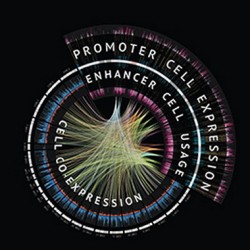 FANTOM5: the complete gene library helping us to understand life.
FANTOM5: the complete gene library helping us to understand life.
Originally launched in 1998 to build a complete gene catalogue, the FANTOM project (functional annotation of the mammals) is a RIKEN-initiative that today – in the fifth round of the project – published a series of coordinated papers: two landmark papers in Nature, and 15 other related papers across nine journals; identifying over 180,000 promoters and 44,000 enhancers on the genome across over 180 human primary cells.
Involved in the consortium and author on one of the Nature papers is the CSC’s Computational Regulatory Genomics group, headed by Dr Boris Lenhard. Lenhard’s team mapped a comprehensive atlas of gene expression across majority of the human tissues with one nucleotide spatial resolution. “It’s freely available to any biomedical researcher in the world, enabling them to investigate expression levels and active promoters of the genes they study across a vast amount of tissues,” explains co-author Piotr Balwierz.
Up until now, the ENCODE project has seen the biggest efforts to functionally characterise the human genome; however, it heavily relies on stable cancerous cell lines, which from a medical viewpoint differ substantially from healthy tissues. FANTOM5 took a different approach and implemented an upgraded version of sequencing from the ENCODE project, known as Cap Analysis of Gene Expression. This technology platform, pioneered by RIKEN, focussed on mapping transcriptional networks (transcription initiation and transcription regulation) from a variety of healthy human and mouse tissues and from undifferentiated cells. “What is unique about FANTOM5 is that it has focused on identifying gene expression from normal primary cells rather than cell lines derived from cancers. This has allowed us to answer questions relating to the evolution and function of human cell types in their natural state, something that is crucial to get a better understanding of what is happening in vivo,” says Owen Rackham, career development fellow within the CSC’s Integrative Genomics and Medicine group.
“We are complex multicellular organisms composed of at least 400 distinct cell types. This beautiful diversity of cell types allow us to see, think, hear, move and fight infection yet all of this is encoded in the same genome. The difference between all these cells is what parts of the genome they use – for instance, brain cells use different genes than liver cells, and therefore they work very differently. In FANTOM5, we have for the first time systematically investigated exactly what genes are used in virtually all cell types across the human body, and the regions which determine where the genes are read from the genome,” says Dr Alistair Forrest, scientific coordinator of FANTOM5.
“The basic library of cell definition that was produced during FANTOM5 is a remarkable step to understanding Life. The library will be an essential resource for developing regenerative medical techniques in the near future,” explains Dr Yoshihide Hayashizaki, general Director of FANTOM.
YJ
References:
1. Consortium, T. F., the RIKEN PMI, & DGT, C. (2014). A promoter-level mammalian expression atlas. Nature, 507 (7493), 462-470.
2. Andersson, R., Gebhard, C., Miguel-Escalada, I., Hoof, I., Bornholdt, J., Boyd, M., Chen, Y., Zhao, X., Schmidl, C., Suzuki, T., Ntini, E., Arner, E., Valen, E., Li, K., Schwarzfischer, L., Glatz, D., Raithel, J., Lilje, B., Rapin, N., Bagger, F. O., Jorgensen, M., Andersen, P. R., Bertin, N., Rackham, O., Burroughs, A. M., Baillie, J. K., Ishizu, Y., Shimizu, Y., Furuhata, E., Maeda, S., Negishi, Y., Mungall, C. J., Meehan, T. F., Lassmann, T., Itoh, M., Kawaji, H., Kondo, N., Kawai, J., Lennartsson, A., Daub, C. O., Heutink, P., Hume, D. A., Jensen, T. H., Suzuki, H., Hayashizaki, Y., Muller, F., Consortium, T. F., Forrest, A. R. R., Carninci, P., Rehli, M., & Sandelin, A. (2014). An atlas of active enhancers across human cell types and tissues. Nature, 507 (7493), 455-461.
3. Sardar, A. J., Oates, M. E., Fang, H., Forrest, A. R. R., Kawaji, H., Consortium, T. F., Gough, J., & Rackham, O. J. L. (2014). The evolution of human cells in terms of protein innovation. Molecular Biology and Evolution, 31 (6), 1364-1374.
